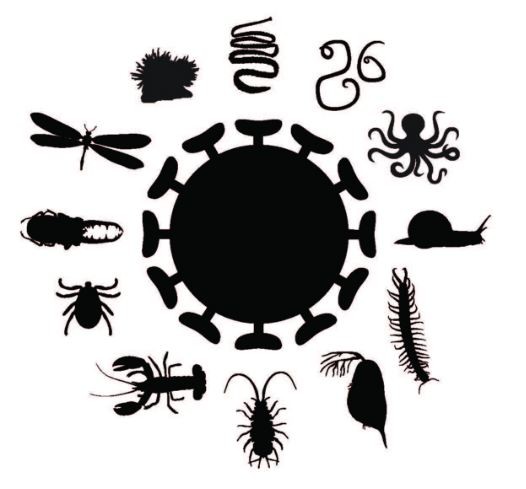Discovery of 1,445 Viruses in Invertebrates Shows Link between these Animals and Human Diseases
| Arthur Dominic Villasanta | | Nov 26, 2016 08:24 AM EST |
(Photo : University of Sydney ) The virosphere.
The discovery of 1,445 viruses in invertebrates (those without backbones such as insects and worms), shows some human diseases like influenza are derived from viruses present in invertebrates.
This discovery sprang from a groundbreaking meta-genomics research of the virosphere was a collaboration between the University of Sydney and the Chinese Center for Disease Control and Prevention in Beijing. It was made possible by new technology that also provides a powerful new way to determine what pathogens cause human diseases.
Like Us on Facebook
Professor Edward Holmes from the Marie Bashir Institute for Infectious Diseases & Biosecurity in Sydney and the School of Life and Environmental Sciences, who led the Sydney component of the project, said although the research revealed humans are surrounded by viruses in their daily lives, these did not transfer easily to humans.
"This groundbreaking study re-writes the virology text book by showing that invertebrates carry an extraordinary number of viruses -- far more than we ever thought," said Prof. Holmes.
"We have discovered that most groups of viruses that infect vertebrates -- including humans, such as those that cause well-known diseases like influenza -- are in fact derived from those present in invertebrates."
The study suggests these viruses have been associated with invertebrates for potentially billions of years, rather than millions of years as had been believed, and that invertebrates are the true hosts for many types of virus.
"Viruses are the most common source of DNA and RNA on earth," he said.
The findings suggest viruses from ribonucleic acid or RNA, whose principal role is to carry instructions from DNA, are likely to exist in every species of cellular life.
"It's remarkable that invertebrates like insects carry so very many viruses. No one had thought to look before because most of them had not been associated with human-borne illnesses."
Although insects such mosquitoes are well-known for their potential to transmit viruses like zika and dengue, Prof. Holmes pointed out that insects should not generally be feared because most viruses were not transferable to humans and invertebrates played an important role in the ecosystem.
The same techniques used to discover these invertebrate viruses could also be used to determine the cause of novel human diseases such as the controversial 'Lyme-like disease' claimed to occur following tick bites.
"Our study utilized new techniques in meta-genomics, which we are also using to provide insights into the causes of human-borne diseases.
"The new, expensive technologies available to researchers which have allowed us to do this landmark project, provide the ultimate diagnostic tool."
Prof. Holmes and his collaborators are conducting human studies using these new techniques to analyze Lyme-like disease and other clinical syndromes.
The paper, "Redefining the invertebrate RNA virosphere," was published in Nature.
Tagsviruses, invertebrates, University of Sydney, Chinese Center for Disease Control and Prevention, Professor Edward Holmes, DNA, RNA
©2015 Chinatopix All rights reserved. Do not reproduce without permission
EDITOR'S PICKS
-

Did the Trump administration just announce plans for a trade war with ‘hostile’ China and Russia?
-

US Senate passes Taiwan travel bill slammed by China
-

As Yan Sihong’s family grieves, here are other Chinese students who went missing abroad. Some have never been found
-

Beijing blasts Western critics who ‘smear China’ with the term sharp power
-

China Envoy Seeks to Defuse Tensions With U.S. as a Trade War Brews
-

Singapore's Deputy PM Provides Bitcoin Vote of Confidence Amid China's Blanket Bans
-

China warns investors over risks in overseas virtual currency trading
-

Chinese government most trustworthy: survey
-

Kashima Antlers On Course For Back-To-Back Titles
MOST POPULAR
LATEST NEWS
Zhou Yongkang: China's Former Security Chief Sentenced to Life in Prison

China's former Chief of the Ministry of Public Security, Zhou Yongkang, has been given a life sentence after he was found guilty of abusing his office, bribery and deliberately ... Full Article
TRENDING STORY

China Pork Prices Expected to Stabilize As The Supplies Recover

Elephone P9000 Smartphone is now on Sale on Amazon India

There's a Big Chance Cliffhangers Won't Still Be Resolved When Grey's Anatomy Season 13 Returns

Supreme Court Ruled on Samsung vs Apple Dispute for Patent Infringement

Microsoft Surface Pro 5 Rumors and Release Date: What is the Latest?













